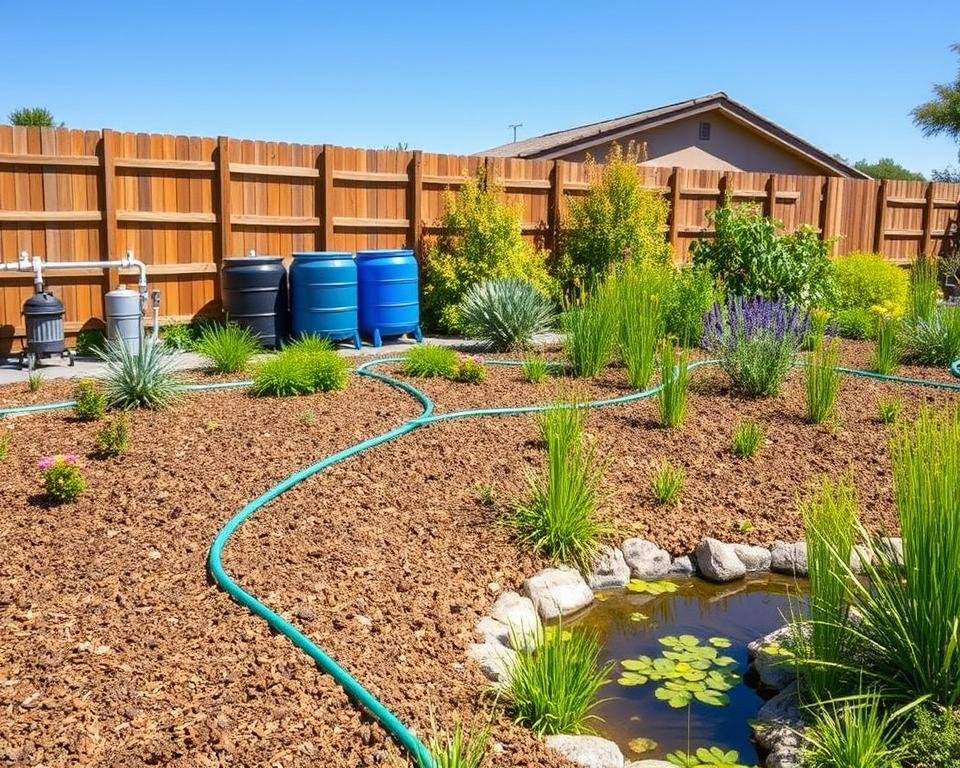In today’s world, embracing eco-friendly gardening and sustainable living is crucial. Starting a sustainable garden at home is both fulfilling and beneficial. It doesn’t matter if you have a large backyard or a small balcony. By adopting sustainable gardening practices, you can turn any space into a thriving, productive haven.
This guide will walk you through the basics of organic gardening. It focuses on creating a garden that harmonizes with nature’s cycles. By growing your own food, you gain more than just fresh produce. You also reduce your environmental footprint and forge a deeper bond with the earth.
Understanding Sustainability in Gardening
Sustainability in gardening goes beyond a passing trend; it’s a pledge for a healthier planet. By adopting sustainable garden design and environmental conservation, gardeners can craft green spaces that are both eco-friendly and sustainable.
What is Sustainable Gardening?
Sustainable gardening entails the creation and upkeep of gardens through methods that conserve resources and foster ecological balance. This approach includes natural pest control, composting organic matter, and water conservation to cut down on usage.
Benefits of a Sustainable Garden
A sustainable garden design brings numerous advantages. It aids environmental conservation by reducing detrimental inputs and safeguarding natural habitats. Moreover, it enhances mental well-being by offering a tranquil, natural retreat for relaxation. Furthermore, sustainable practices can lead to financial savings by decreasing the need for water, fertilizers, and pesticides.
Reducing Your Environmental Footprint
To lessen your garden’s environmental impact, adopt methods that minimize resource consumption and waste. Techniques like rainwater harvesting and drip irrigation can drastically reduce water usage. Incorporating composting also recycles organic waste, enriching the soil without the need for chemical fertilizers.
- Use native plants adapted to local conditions.
- Implement efficient watering systems.
- Practice composting and mulching.
- Introduce natural predators to manage pests.
| Technique | Benefit |
|---|---|
| Composting | Enriches the soil and reduces waste |
| Drip Irrigation | Minimizes water usage by targeting plant roots |
| Natural Pest Control | Reduces reliance on chemical pesticides |
| Native Plants | Promotes local biodiversity and needs less water |
Choosing the Right Location for Your Garden
Starting a garden requires picking the perfect spot. Key elements to consider include sunlight exposure, soil quality, and available space for optimal garden placement. This guide will walk you through these essential factors to aid in making informed decisions for your garden.
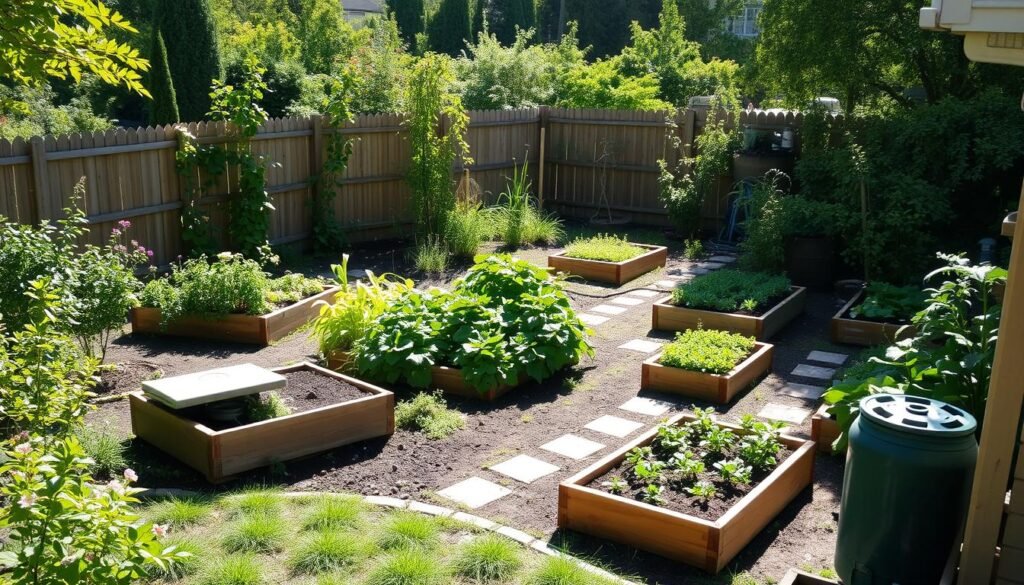
Assessing Sunlight Exposure
Understanding sunlight requirements is crucial for a garden’s success. Plants vary in their sunlight needs, from full sun to partial shade. By observing your garden during the day and noting the sun’s impact, you can pinpoint the ideal spots for your plants.
Soil Quality and Preparation
Soil health is vital for plant growth, influencing water retention, nutrient availability, and root development. Begin by testing your soil’s pH and nutrient levels. Adding compost or organic matter can significantly improve soil quality. Regularly assessing and enhancing soil conditions ensures your plants grow optimally.
Space Considerations
Maximizing garden space is key, especially for limited areas. Consider vertical gardening techniques, using trellises, towers, or walls to grow plants upwards. Container gardening is another flexible option, allowing for a variety of plants in pots or raised beds. Strategic planning and creative space utilization can greatly enhance your garden’s productivity.
Essential Tools and Materials Needed
Embarking on a sustainable gardening journey demands a meticulous selection of tools and materials. It’s vital to incorporate eco-friendly gardening equipment and sustainable garden tools. This approach minimizes your environmental impact and fosters a healthy ecosystem. Below, we outline the fundamental items you should consider.
Basic Gardening Tools
Every gardener’s arsenal should include basic self-care tools. These essentials include ergonomic hand trowels, pruners, and cultivators. Choosing tools crafted from sustainably-sourced materials not only enriches your gardening experience but also champions environmental conservation.
- Hand Trowel
- Pruners
- Cultivators
- Watering Can
- Gloves
Choosing Sustainable Materials
When selecting materials for your garden, it’s crucial to evaluate their environmental footprint. Opt for biodegradable planting materials such as compostable pots and coco fiber planters. Furthermore, utilizing recycled plastic or sustainably harvested wood reduces waste and conserves resources.
- Biodegradable Planting Pots
- Recycled Plastic Containers
- Coco Fiber Planters
- Sustainably Harvested Wood Planters
Innovative Indoor Plant Pot Options
For indoor gardening enthusiasts, there are numerous innovative pot options that blend functionality with aesthetics. Seek out pots designed to optimize space and support plant health, such as self-watering pots or modular planters. These modern solutions cater to urban gardeners, ensuring your plants flourish.
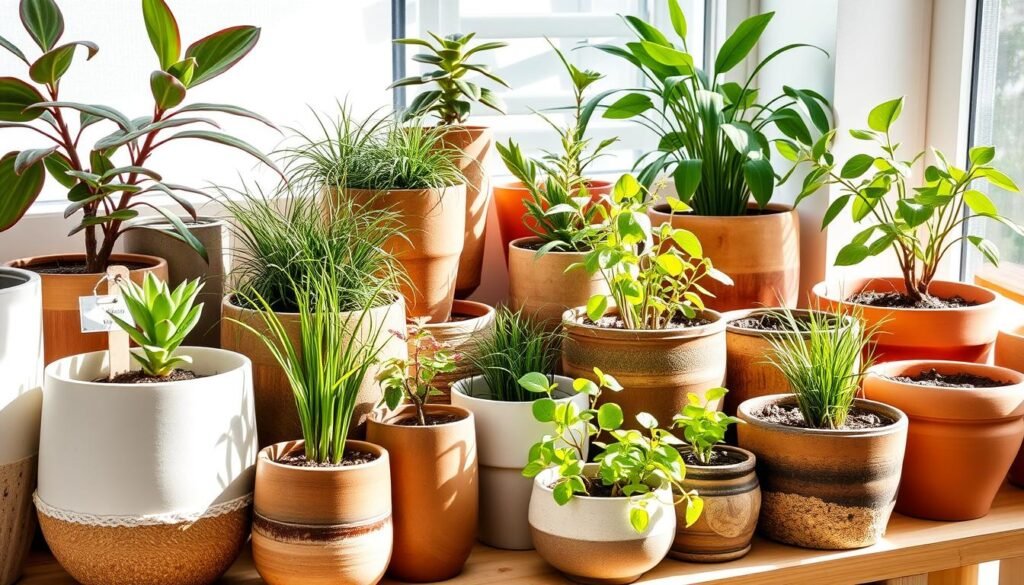
| Type of Pot | Benefits | Materials |
|---|---|---|
| Self-Watering Pots | Maintains moisture levels | Recycled Plastic, Ceramic |
| Modular Planters | Space-saving and flexible | Biodegradable, Recyclable |
| Hanging Planters | Ideal for small spaces | Fabric, Ceramic |
Picking the Right Plants for Your Garden
Choosing the right plants is crucial for a sustainable, thriving garden. We’ll delve into the differences between native and non-native plants. We’ll also explore a seasonal guide for plant selection and the benefits of edible plants in your garden.
Native vs. Non-Native Plants
Native plant gardening offers significant advantages. Plants native to your region are more resilient against pests and diseases. They also need less water and support local pollinators. Non-native plants, while attractive, can harm local ecosystems by becoming invasive.
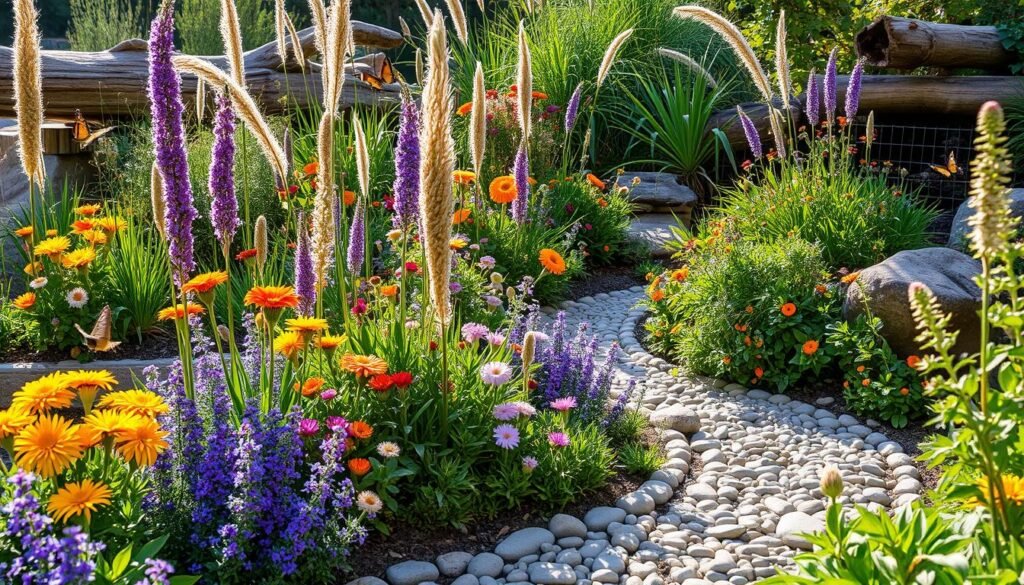
Seasonal Plant Selections
Adopting a seasonal gardening approach is key to a vibrant garden. Plants bloom and grow best at specific times, ensuring your garden remains dynamic. Spring is ideal for flowers and leafy greens. Summer is best for warm-season vegetables and perennials.
Fall is the season for root vegetables and certain herbs. This strategy promotes continuous growth and garden diversity.
Edible Plants for a Sustainable Garden
Adding edible plants to your garden boosts sustainability. Tomatoes, peppers, and salad greens are great for beginners. Herbs like basil, mint, and rosemary add flavor and support sustainable gardening.
Homegrown food reduces reliance on commercial produce, lowering carbon footprints and promoting self-sufficiency.
By selecting native, seasonal, and edible plants, you create a garden that’s both beautiful and sustainable.
How to Maintain a Sustainable Garden
Keeping a sustainable garden requires a blend of practices that ensure your garden’s health and protect the environment. Eco-friendly upkeep includes composting, organic pest control, and water-efficient gardening. These methods conserve resources and keep your garden thriving.
Composting is crucial for sustainable gardening. It involves turning organic waste like vegetable scraps, leaves, and grass clippings into nutrient-rich soil. This process cuts down on waste and supports plant growth without synthetic fertilizers.
Organic pest control is equally important. Instead of synthetic pesticides, use natural options like neem oil, insecticidal soaps, or planting companions. These methods effectively manage pests without harming beneficial insects or the environment.
Water-efficient gardening is key for saving water. Techniques such as mulching, choosing drought-resistant plants, and using rain barrels help. These methods cut down on water use and keep soil moist, ensuring your garden stays healthy in dry times.
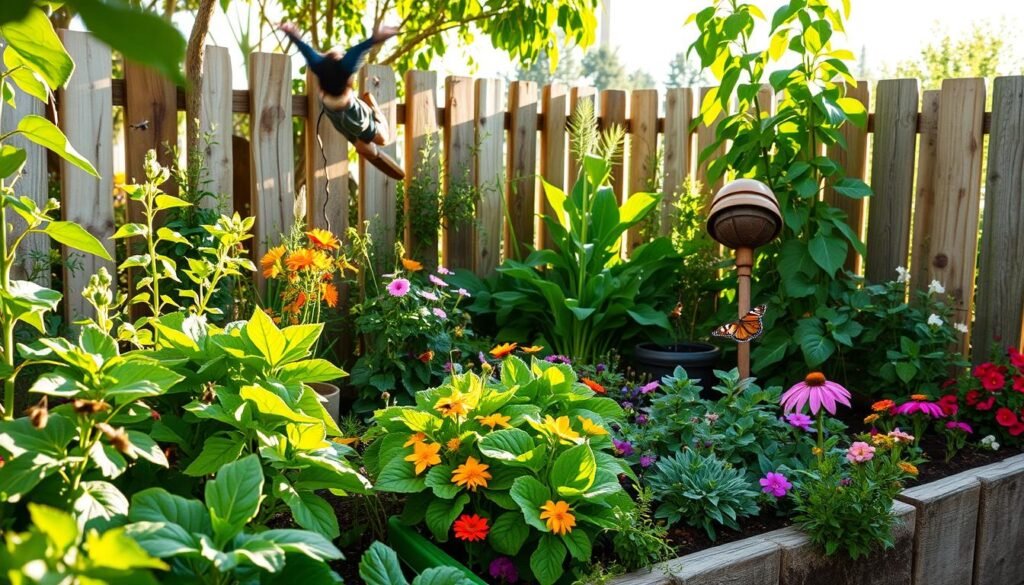
| Maintenance Method | Key Benefits |
|---|---|
| Composting | Enriches soil, reduces waste |
| Organic Pest Control | Protects beneficial insects, eco-friendly |
| Water-Smart Gardening | Conserves water, maintains soil moisture |
Adopting these eco-friendly practices makes maintaining a garden easier. By focusing on composting, organic pest control, and water-efficient gardening, you help the environment and keep your garden vibrant.
Garden at Home: Incorporating Indoor Plants
Adding indoor plants to your living space boosts both the look and air quality, enhancing well-being. Discover how to pick the best indoor plant pots and decorative containers that match various styles. Learn essential tips for keeping indoor plants thriving.
Best Indoor Plant Pots
Choosing the right pots is key for indoor plant care. Opt for materials like ceramic, terracotta, or self-watering pots for their excellent air circulation and drainage. These materials support healthy plant growth and come in styles that fit any decor.
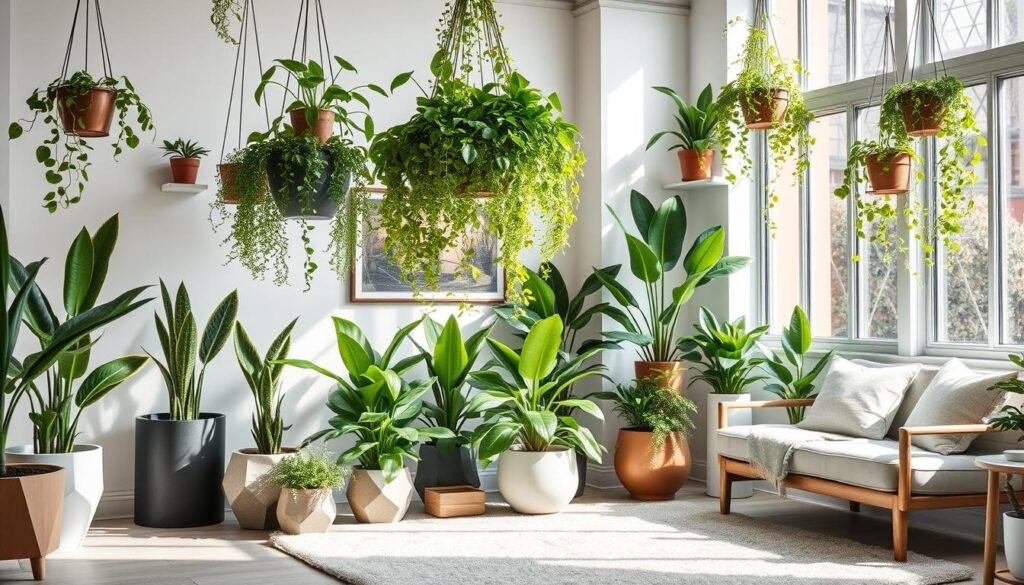
Decorative Plant Containers for Style
The type of container you choose can greatly affect your living space’s look. From modern geometric pots to rustic wooden planters or sleek metallic ones, each adds a unique touch. These containers not only enhance style but also make your space practical and chic.
Tips for Indoor Plant Care
Looking after indoor plants is more than just watering them. It’s about ensuring they get enough light, maintaining soil moisture, and keeping an eye out for pests. Place plants near windows for sunlight and rotate them for balanced growth. Follow these tips for vibrant, healthy greenery indoors.
Creative Ideas for Decorative Plant Containers
Elevating your garden’s look requires a mix of creativity and practicality. The right plant containers can transform your garden, offering both style and utility. We’ll delve into three key areas to spark your decorative plant container designs.
Modern and Stylish Plant Pots
Modern plant pots have evolved, embracing innovative designs that complement contemporary gardens. Whether you lean towards minimalist or bold styles, there’s a wide array of options. These pots, crafted from creative materials and unique shapes, can elevate your garden’s look, adding a chic yet practical element.
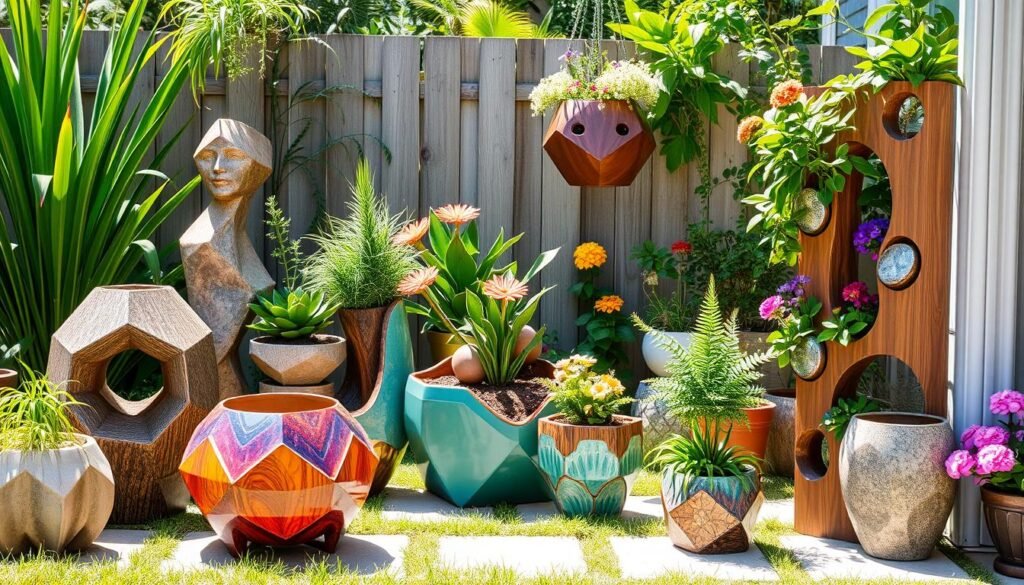
Unique Indoor Plant Pots
For indoor gardening, choosing distinctive plant pots can leave a lasting impression. Select containers that stand out, whether through their shape, color, or whimsical design. These pots not only house your plants but also spark conversations, enriching your home’s decor. By embracing creative and imaginative designs, even ordinary spaces can become lush, engaging areas.
Ceramic Planters and Their Benefits
Ceramic planters bring numerous benefits to both indoor and outdoor gardens. Their durability and timeless beauty make them ideal for various climates. These planters enhance garden aesthetics, combining rustic charm with modern elegance. They also offer better insulation for roots and a variety of designs, ensuring your containers are both functional and beautiful.
Conclusion
Starting a sustainable garden at home is a pledge to the environment and a deeply personal journey. We’ve delved into the core of sustainable gardening, from grasping its principles to selecting the ideal plants and creative indoor pot ideas. Adopting sustainable gardening practices beautifies your home and lessens your environmental impact.
Choosing the right tools and materials, evaluating your garden’s location, and maintaining it well are key to sustainable gardening. By picking the correct plant types and using decorative garden methods, you can establish a lively, eco-friendly haven that flourishes all year. Adding indoor plants and stylish containers can turn your living area into a verdant sanctuary, blending beauty with sustainability.
As you delve deeper into sustainable gardening, every small action makes a significant difference. This guide provides the insights and motivation needed to cultivate a sustainable garden and adopt a greener lifestyle. By merging your creative ideas with practical advice, achieving sustainable gardening success is both possible and deeply fulfilling.
FAQ
What is Sustainable Gardening?
Sustainable gardening is about using eco-friendly practices to lessen environmental impact and keep your garden healthy. It includes composting, organic fertilizers, and water-saving techniques.
What are the Benefits of a Sustainable Garden?
Sustainable gardens help reduce your environmental footprint, support biodiversity, and conserve water and soil. They also provide fresh, organic produce for your home.
How Can I Reduce My Environmental Footprint in Gardening?
Reduce your environmental footprint by using water-smart gardening, natural pest control, composting, and choosing sustainable materials and tools.
How Do I Assess Sunlight Exposure for My Garden?
Check how much direct sunlight each garden spot gets daily. Most plants need at least 6 hours of sunlight. However, this can vary by plant type.
What Should I Consider for Soil Quality and Preparation?
Test your soil’s pH, texture, and nutrient levels first. Improve soil quality by adding organic matter like compost or manure to boost fertility and structure.
What are Space Considerations for Small Gardens?
For small gardens, maximize space with vertical gardening, container plants, and strategic layout planning. This allows for diverse plantings in a small area.
What Basic Gardening Tools Do I Need?
You’ll need a trowel, pruning shears, a watering can, gloves, and a spade. Choose tools made from sustainable materials that are built to last.
What are Some Innovative Indoor Plant Pot Options?
Innovative indoor plant pot options include self-watering pots, hydroponic systems, and stylish pots that enhance your space’s look while supporting plant health.
How Do I Choose the Right Plants for My Garden?
Pick plants based on their sunlight, water, and climate needs. Native species often need less care and support local ecosystems. Edible plants provide fresh produce.
How Do I Maintain a Sustainable Garden?
Keep your garden sustainable by weeding, mulching, maintaining compost heaps, using organic pest controls, and efficient irrigation methods.
What are the Best Indoor Plant Pots?
The best indoor plant pots offer good drainage, are made from breathable materials like terracotta, and match your decor. Ceramic planters are popular for their durability and style.
How Do I Care for Indoor Plants?
Care for indoor plants by ensuring they get enough light, water, and the right soil. Fertilize them occasionally to keep them healthy and thriving.
What are Some Creative Ideas for Decorative Plant Containers?
For decorative plant containers, use repurposed items like teacups or cans, modern indoor pots, or unique pots that add personal style to your space.
